September 14, 2012
Air Date: September 14, 2012
FULL SHOW
SEGMENTS
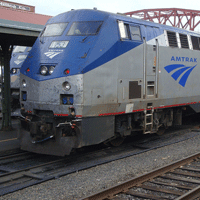
Full Steam Ahead for Amtrak
/ Steve CurwoodView the page for this story
Amtrak's ridership is up and subsidies from the government are down. Yet many in Congress and Presidential hopeful, Mitt Romney, are calling to end federal funding for the national train system. Living on Earth’s Steve Curwood talks with Amtrak representative Steven Kulm. (06:00)
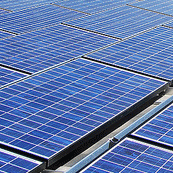
Green Energy Jobs Growing
/ Steve CurwoodView the page for this story
President Obama’s call for creating new jobs through renewable energy development is a reality in Massachusetts. Alicia Barton McDevitt, the CEO of the Massachusetts Clean Energy Center, tells host Steve Curwood that the number of green energy jobs in the Bay State has grown by more than 11 percent. (06:30)
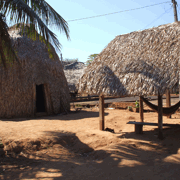
Protecting Forests, Sequestering Carbon
/ Bobby BascombView the page for this story
We update a story about an indigenous tribe in the Amazon that’s trying to protect its forest by selling carbon credits on the voluntary carbon market. Living on Earth’s Bobby Bascomb reports. (21:00)
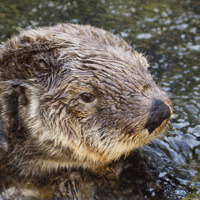
Otters and Climate Change
/ Steve CurwoodView the page for this story
According to two scientists at the University of California at Santa Cruz, a small animal could have a big impact on climate change. Professor Chris Wilmers explains how sea otters could be key to preserving kelp forests, one of the world’s great carbon sinks. (06:10)
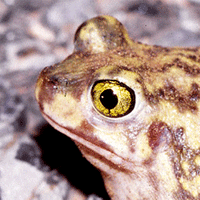
Toads in Tucson
/ Sarah BromerView the page for this story
The US southwest is typically a dry and dusty desert, yet in summer torrential rains can spawn the sudden appearance of amphibians. Sarah Bromer reports from Tucson. (08:30)
Show Credits and Funders
Show Transcript
HOST: Steve Curwood
GUESTS: Steven Kulm, Alicia Barton McDevitt, Chris Wilmers
REPORTERS: Bruce Gellerman, Bobby Bascomb, Sarah Bromer
[THEME]
CURWOOD: From Public Radio International - this is Living on Earth. I'm Steve Curwood. President Obama says clean energy as a key to more jobs. In at least one state - it's already working well:
MCDEVITT: We saw a significant increase in manufacturing and assembly jobs at a time when economic trends are trending the other way. That's because we have helped companies grow and locate here and including keep their manufacturing operations here.
CURWOOD: Also - the toads that mysteriously materialize after torrential rains in the desert:
BROMER: It sounded like waaaaahhhhh [imitating sound]
ROSEN: waaaahhhh? [imitating sound]
BROMER: Yeah, like that.
ROSEN: I fully expected it to be nothing but Couch’s spadefoot, because of their ability to use such short-lived water.
CURWOOD: But mosquito control often dooms the tadpoles - that and more this week, on Living on Earth. Stick Around!
[THEME]
Full Steam Ahead for Amtrak
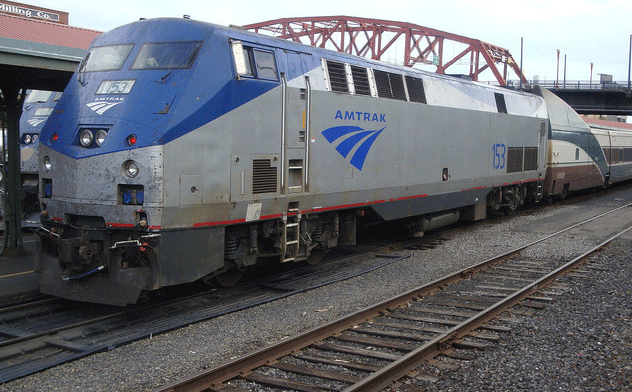
(Environmental Blog Flickr Creative Commons)
CURWOOD: From the Jennifer and Ted Stanley Studios in Boston, this is Living on Earth. I'm Steve Curwood. For each of the last 11 months, Amtrak has carried a record number of passengers. 30 million people let the train take the strain last year - and passengers on the Downeaster have noticed.
[SOUND OF THE INSIDE OF A TRAIN]
MAN: Ridership all summer has been nuts. We had days where there were people wandering the aisles looking for seats. There were people who were sitting on the floor because every seat was taken.
CURWOOD: You’re a conductor here on Amtrack, can I ask your name?
JIM: Jim.
CURWOOD: What do you think the people find best about the train - what are they most excited about?
JIM: I think it’s like… leave the driving to somebody else. We have the café car, you know, there’s no airport-type security to board, you’re free to walk around and you’re not confined to your seat.
WOMAN: I think it’s very convenient, people will prefer to take the train– especially commuters– to sit rather than park in Boston…
MAN 2: I get to sit in a nice comfortable seat with my computer in front of me. I get to read my blog, I get to read the news, I get to listen to music.
[TRAIN SOUNDS]
WOMAN 2: Gas prices are too high. Who wants to drive down to Boston if you don’t have to? There’s nowhere to park once you get to the city… and the people on the train are so cool! See, we don’t want them to know about Amtrack because we want to keep it a special club, just us.
WOMAN 3: (Laughs) I don’t know what to say to that.
CURWOOD: Yet passenger trains depend on government subsidies - which are targeted by many Republicans in Congress - and by the presidential challenger, Mitt Romney.
ROMNEY: The subsidy for Amtrak, I would eliminate that…
CURWOOD: But Amtrak's Steven Kulm says the rail service has a good case to make.
KULM: Well, there's a growing demand for travel by rail across the country. Not only are gas prices high and staying high, but there is some frustration with the aviation system and all of the hassles that go with flying. Plus, Amtrak is actually improving services. We’ve recently added wi-fi to a number of our trains, so 75 percent of our passengers have access. But also in the last few years, we’ve increased service, working with our state partners. So, there is a demand out there in the states and by the public generally, to move to rail as an alternative to congested highways and to aviation.
CURWOOD: Now, this record number of passengers, is this a fluke we can attribute to rising gas prices, or is this a trend?
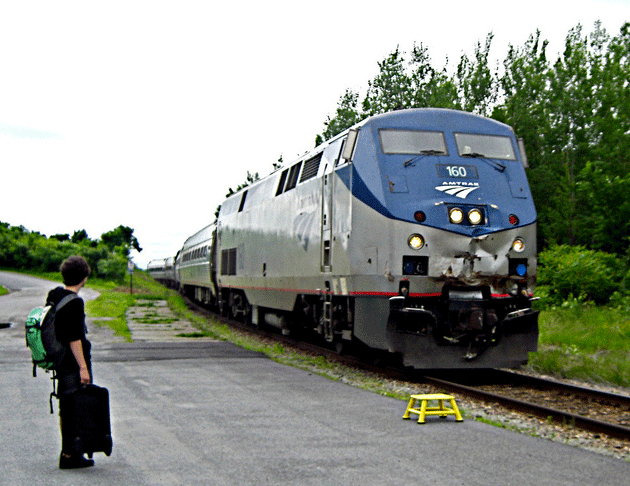
Ridership on Amtrak has been steadily increasing. (Photo: Darkroom Daze Flickr Creative Commons)
KULM: It is definitely a long-term trend. Amtrak’s ridership has increased in eight of the last nine years. Our ridership has gone up 44 percent since FY 2000, and it’s across the board. It’s in the Northeast corridor, it’s on our 15 state supported services, as well as our long distance trains.
CURWOOD: So tell me, just how climate friendly is the Amtrak system?
KULM: Well, Amtrak and rail travel in general is more energy efficient than flying or the highway. Certainly on the Northeast corridor where it’s electrified… a lot of the power comes from hydro-based sources. Plus, we’re sort of reducing the nation’s dependence on foreign oil by using the electricity and the power grid just here at home.
CURWOOD: Now, Republicans point to the subsidies that support Amtrak - it’s what a half a billion dollars this year at least - and call it unsustainable. How do the subsidies for Amtrak compare to the subsidies for other forms of transportation?
KULM: Well, we look at the operating support that we get from the federal government. This current year it’s about $466 million dollars. That is down considerably from the high point, from 2004, I believe we were over $700 million for operating only. And, for next year, Amtrak is actually asking for less than we got this year!
CURWOOD: And what will that number be?
KULM: We’re asking for about $450 million dollars. And that number, just to put it in context - I understand it takes about $450 million dollars for a single space shuttle mission. And we’re providing train service in 46 states and we’re making a national connection for people that doesn’t exist anywhere else.
CURWOOD: So, why this long standing struggle over subsidies for Amtrak? I mean, some would say that this is another example of the fundamental differences about the role of government in our lives. Do you think that there could ever be an agreement?
KULM: Well, there has been an agreement for 41 years. Amtrak has existed for 41 years - has always come to an agreement that when we were created, Congress said that inner-city rail was a vital piece of the transportation network. That was in 1970-71.
So, the current legislation that we’re operating under, passed in 2008, also says that. And, actually, on the federal support, Amtrak covers 85% of our operating expenses, so only 15% of our operating costs are covered by that federal subsidy. And we think that’s a pretty good bargain.
CURWOOD: Now, some would argue that passenger trains are a public good and shouldn’t need to turn a profit, just the way that schools are - they don’t need to turn a profit - what do you folks at Amtrak think about that?
KULM: Well, we are providing a national mission. And in the end, we will need some public support - just like the other modes of transportation: highways get capital funding, certainly the airports get capital funding, so we believe that Amtrak, which itself is essentially a mode of transportation, should be receiving some public funds as well for that.
We try to do our best to reduce that level of support, and we’ve succeeded in that, but in the end we’re still going to need some money to, particularly, keep our long-distance rails together, that really connect this nation in a way that no other transportation service does.
CURWOOD: Steve Kulm is the spokesperson for Amtrak. Thank you so much, sir.
KULM: Alright, thank you for the opportunity.
Related link:
Amtrak’s Website on the Environment
Green Energy Jobs Growing
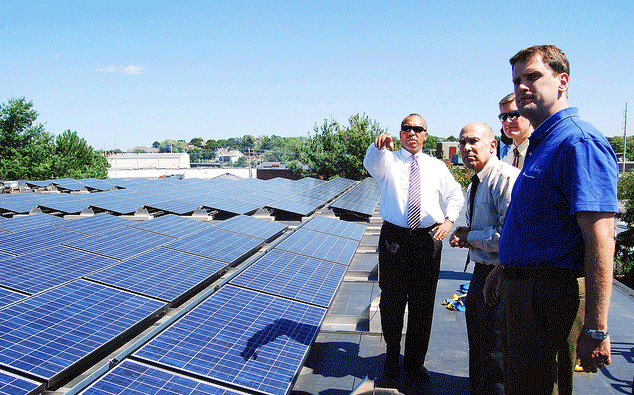
Massachusetts Governor Deval Patrick tours a solar panel installation. (Office of Governor Patrick)
CURWOOD: Trains may be one way to reduce the use of fossil fuels - renewable energy is another.
OBAMA: We have doubled our use of renewable energy, and thousands of Americans have jobs today building wind turbines and long-lasting batteries.
CURWOOD: President Obama might have had Massachusetts in mind - it's leading the pack in generating green jobs. A recent Industry Report on the sector lays out precisely how the Bay State has achieved double digit growth, and joining me now is Alicia Barton McDevitt, the CEO of the Massachusetts Clean Energy Center, Welcome!
BARTON MCDEVITT: Thank you for having me!
CURWOOD: Now, an 11 percent job growth rate is phenomenal. I mean, even China doesn’t have that kind of growth rate in it’s over all economy. And in this country right now, where it’s more like one percent job growth…how has Massachusetts been able to do this?
BARTON MCDEVITT: Well, it is phenomenal. And it is because we have come together through the state government, working with business partners, working with academic institutions, working with environmental advocates… to develop programs and policies that work that make business predictable; that allow businesses to grow and get a foothold in the market and then expand here in Massachusetts.
CURWOOD: What do these companies look like? I imagine they’re mostly small.
BARTON MCDEVITT: They are! The vast majority of the 5,000 firms that are participating in the clean energy economy here in Massachusetts are small businesses with less than 10 employees. We are growing these businesses from the ground up - from small operations and startups to hopefully larger companies that generate additional jobs as they grow.
CURWOOD: Tell me, what is a clean energy job?
BARTON MCDEVITT: A clean energy job can be a lot of different things. There are a variety of different technologies that fall under the rubric of clean energy. That would of course include things like wind and solar and those types of clean energies.
The largest sector of clean energy jobs, actually, in Massachusetts is around clean energy measures around the energy efficiencies measures that are installed in homes and businesses, and even in school buildings across the Commonwealth.
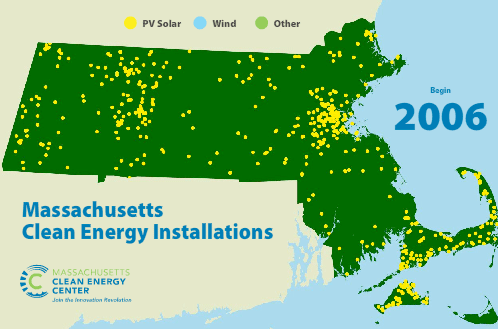
Massachusetts solar installations are represented in yellow on this map. (Massachusetts Clean Energy Center)
In terms of the types of jobs that are available, some of those are around installation and maintenance, which is the largest number of jobs by sector. There are sales and distribution jobs associated with that; engineering and research, manufacturing and assembly, which I should point out grew 36.6 percent from 2011-2012, which is a significant jump for that sector of the economy.
CURWOOD: Wait a second, you’re saying that manufacturing growth in the clean energy sector grew by 36 percent?
BARTON MCDEVITT: That’s correct. We saw a significant increase in manufacturing and assembly jobs, and that is something that we’re very proud of, particularly at a time when the traditional economic trends are trending the other way. But that’s because we’ve helped companies grow and locate here and including keep their manufacturing operations here.
CURWOOD: How did the federal stimulus program affect the growth of clean energy jobs in Massachusetts?
BARTON MCDEVITT: Well, there was a huge infusion of investment dollars that came as a result of the federal stimulus act. There were many dollars put in place to directly incentivize, for example, renewable energies and energy efficiencies at municipal buildings - for example, local wastewater and drinking water treatment plants.
There were dollars made available to facilitate rebates for individual homeowners. And all of those dollars that flowed through the federal Department of Energy and all of those other agencies, definitely put a spark behind some of this expansion and adoption of technologies that we have seen.
CURWOOD: So how has all of this development of clean energy jobs in Massachusetts, affected the Massachusetts’s carbon footprint?
BARTON MCDEVITT: Well, we have seen greenhouse gas emissions go down over time in Massachusetts - part of that is related to larger global factors like the slow-down in the economy. Or, natural gas replacing coal for some of our power generation. But that’s only part of it.
We have also seen a significant expansion in energy efficiency measures and installed renewable energy that have significantly driven down emissions. So, for example, Massachusetts this year was ranked number one in the country by the American Council for an Energy Efficient Economy. That’s the first time that Massachusetts has claimed that top spot from California, so we’re very proud of that. We’ve also seen solar grow a tremendous amount in recent years - to over 146 megawatts of installed capacity in the state.
CURWOOD: So what are the dark spots on this bright horizon?
BARTON MCDEVITT: Well, some of the challenges facing the clean energy industry right now involve uncertainties either in the marketplace or the landscape for incentives. So, for example, at the federal level there are certain tax incentives, like the production credit, that are available to wind developers whose future is uncertain and could be dependant upon the outcome of the election.
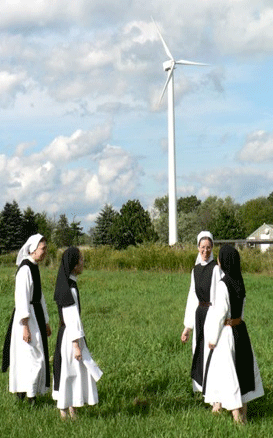
Mount Saint Mary’s Abbey in Waltham, MA invested in a windmill to power their abbey. (Massachusetts Clean Energy Center)
For example, Mitt Romney has said that he opposes that production tax credit. That makes it difficult for businesses that are trying to expand and plan to know what incentives will be available and how to price their products. Similarly, there are uncertainties in the marketplace around the prices of other sources of energy that compete with renewable technologies.
So, I think many people have heard about the advances in technology that have made natural gas more available through hydraulic fracturing - that has really driven down the price of natural gas and that has an impact on the competitiveness in an open market for technologies like wind and solar.
CURWOOD: So, what’s the forecast that the economists that you consult on this for this growth - you had 11 percent growth in this sector - next year you expect…
BARTON MCDEVITT: Next year we expect to have even more growth in this sector, I’m pleased to report. The employers we surveyed are projecting approximately a 12.4 percent growth in this sector next year. That would be a significant new expansion, and again I think far out-paces any other sector of the economy and predictions for growth in other areas.
CURWOOD: Alicia Barton McDevitt is CEO of Massachusetts Energy Center. Thanks for coming in.
BARTON MCDEVITT: Thanks so much for having me.
Related links:
- Massachusetts Clean Energy Center
- Massachusetts Clean Energy Center Industry Report
[MUSIC: Andrew Bird “Near Death Experience Experience” from Break It Yourself (Mom & Pop Records 2012).]
CURWOOD: Just ahead – counting the carbon - the bar-code comes to Amazon rainforest trees. Stay tuned to Living on Earth!
[CUTAWAY MUSIC: Fourplay: “Logic Of Love” from Esprit De Four (Concord Music 2012).]
Protecting Forests, Sequestering Carbon

A young Surui girl. (Photo: Bruce Gellerman)
CURWOOD: It’s Living on Earth, I'm Steve Curwood. Around the time of the Copenhagen Climate Summit back in 2009, we aired a number of reports about the UN mechanism which seeks to Reduce Emissions from Deforestation and Degradation - known as REDD.
The idea is to channel payments to countries or communities to enable them to protect their forests and so help limit climate disruption. Among the places we visited was the Brazilian Amazon, where one remote indigenous tribe, the Surui, was pioneering a new forest management plan.
Well, there are some new developments in that story - but before we hear them, here's a reminder of the original report from Living on Earth's Bruce Gellerman, and Bobby Bascomb with their translator, Marco Lima.
[SOUNDS OF UNFOLDING MAP]
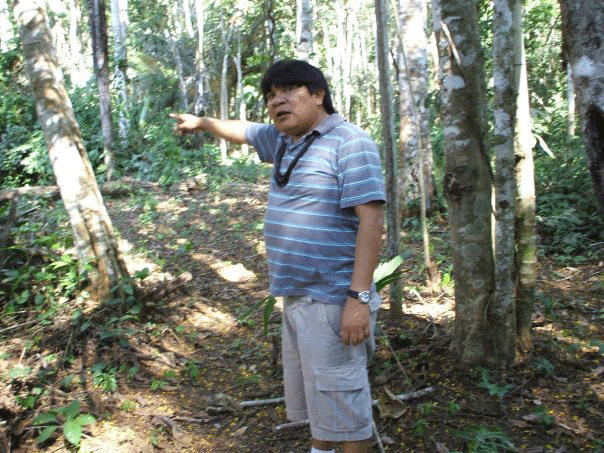
Almir Surui points the way forward in the Surui Forest. (Photo: Bobby Bascomb)
BASCOMB: Chief Almir Surui carefully unfolds a map and spreads it on a table. The Surui have been living here in the southwest Amazon for thousands of years, yet this map of their homeland is the first of its kind.
ALMIR: [Translation] If you look individually to every single spot, every single creek. What we did here is simply understand deep inside our wealth. Our people know what we have.
GELLERMAN: On the map are places where the Surui harvest cashews and other foods from the forest. And tiny symbols mark sites where shamans performed rituals and the Surui fought historic battles.
GELLERMAN: What is this, it looks like little huts.
ALMIR: [Translation] Powantigua is the place where there was made the contact with the Surui people.
GELLERMAN: First contact with the Surui was September 7th 1969. That’s the day Brazilian government agents first approached the tribe. Settlers soon followed, stealing 80 percent of the Surui land and bringing new diseases that killed 90 percent of the people.
[MAP UNFOLDING SOUNDS]
BASCOMB: Today, the Surui are fighting back. We’re in the Surui business office in the small town of Cacoal. On a wall hangs a bow and arrow and a long, sharp spear.
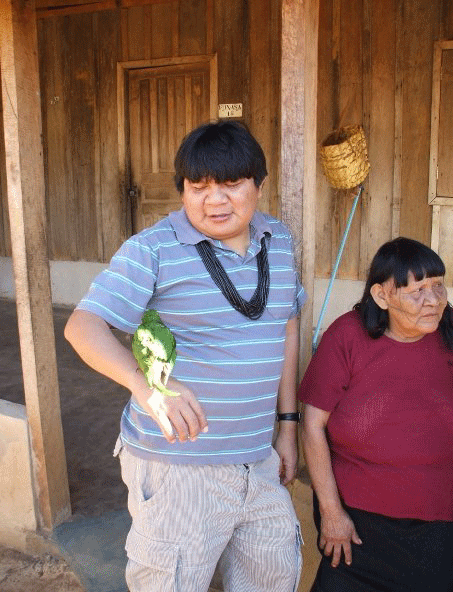
Almir Surui holding a parrot next to his mother in the Surui village (Photo: Bobby Bascomb)
[TYPING ON COMPUTER]
BASCOMB: And on a conference table: a laptop. The Surui are now defending their land with computers, GPS units, and satellite images donated by the U.S.-based Amazon Conservation Team. The Surui used the technology to create this detailed map of their reserve.
ALMIR: [Translation] I'm going to show you now how do we want to use technology to protect our territory.
[CLICKING SOUNDS ON COMPUTER]
BASCOMB: So, right now you’re using your laptop to zoom in on – is that your house right there?
ALMIR: [Translation] Here you can see very well how much deforestation we have and also above here you can see the other indigenous territory. All the whites you can see, all the white spots, these are farms that have already destroyed the forest.
BASCOMB: To preserve what’s left of the forest and replant what’s been lost to settlers, Chief Almir has devised a 50-year management plan. It’s a pioneering Indigenous REDD project. The Surui hope to profit by protecting their 600 thousand acre forest and auction off the carbon stored in the trees.
GELLERMAN: They plan to sell the forest carbon as credits to companies and countries that want to offset their climate disrupting emissions. To verify their carbon inventory, the tribe uses images from orbiting satellites. In just two generations, the Surui have gone from the Stone Age to the Space Age.
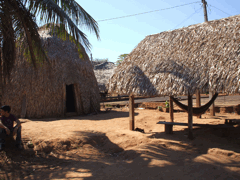
Except for the telephone pole this could have been a scene of a Surui village 1,000 years ago. (Photo: Bruce Gellerman)
GELLERMAN: You know it’s given you a whole different viewpoint on the world. When you show this to the people of your tribe – when you show these satellite pictures – what do they say?
ALMIR: [Translation] We thought that these images were something like coming from the eye of a monster who likes to eat forest, then we thought, well, maybe we can use the eyes of this monster to protect the forest.
[ROAD SOUNDS]
BASCOMB: It’s 25 bone-jarring miles from Chief Almir ’s office to the Surui tribal village. Our guide, Marco, drives while we bounce around in the back. Almir sits in front.
GELLERMAN: We travel past fields that have been slashed for their hardwood and burned to make way for cattle ranches and soy farms. All that remains of what was once a dense rainforest are knee-high tree stumps, and bitter memories of first contact.
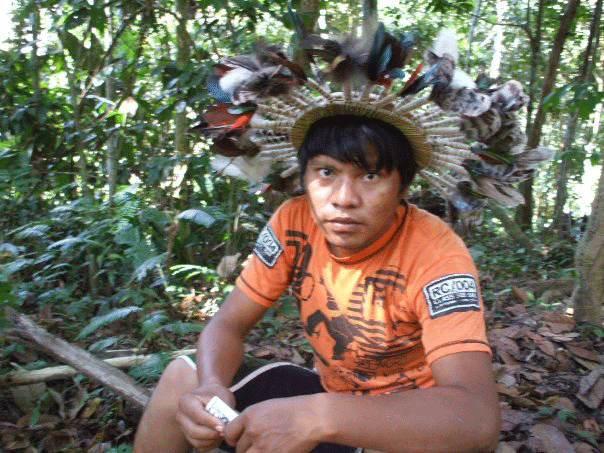
A young man in the Surui rainforest. (Photo: Bruce Gellerman)
ALMIR: [Translation] We had to give up on our land to survive, to remain alive. I’m not against farms; I’m not against production. The only thing I’m really concerned that the white man should see is that they have to grow with sustainable responsibility.
GELLERMAN: When you see this does it make your angry? Does it make you…?
ALMIR: [Translation] I get first of all sad because I really don’t know what happened to a guy like this who simply comes in and clears everything. I don’t know what goes on in his brain.
LIMA: Now we are we getting to the Surui people and as you can see the amazing difference of the vegetation of what you can see over there and what is in here – there you can see the cattle and over there you can see pristine forest.
GELLERMAN: The difference couldn’t be more dramatic: deforestation ends where Surui territory begins. Like a surgeon’s knife, the chain saws of illegal loggers have cut clean, separating dense Surui forest reserve from open farmland.
GELLERMAN: At a sharp bend in the road we see loggers leaning on dirt motorbikes and they see us. We get cold hard stares. I want to stop and talk to the loggers.
BASCOMB: But Almir says, oh, no, no, no. Keep going.
ALMIR: [Translation] Let's not stop. Let’s not stop. They’ll give us a hard time.
GELLERMAN: Why's that?
ALMIR: [Translation] They threat us because all this logging here is illegal. I was threatened so many times here.
BASCOMB: Really?
ALMIR: [Translation] It’s very dangerous.
BASCOMB: Over the past decade 11 tribal elders in the Amazon have been assassinated. Two were Surui. It was almost three: a few years ago someone tried to run Almir off this road. He was evacuated out of Brazil, and when he returned he was promised protection, but Almir says, that was a joke.
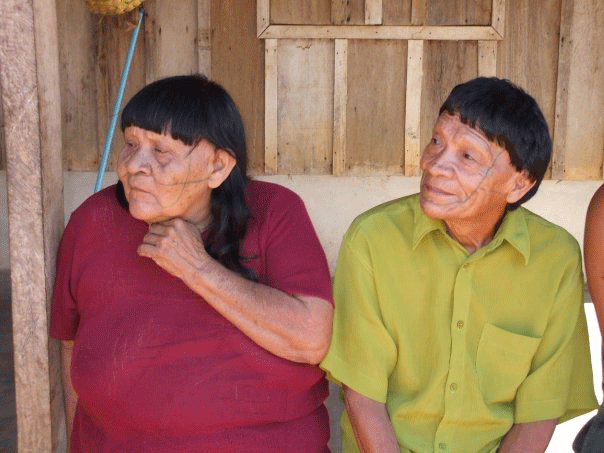
Chief Almir’s parents are the last generation with tribal tattoos. The tradition ended after first contact with white settlers in 1969. This photo was taken in 2009. Almir’s father has since passed away. (Photo: Bobby Bascomb)
ALMIR: [Translation] The secret security they were supposed to take care of me it so secret that I’ve never seen it. [Laughs]
[TRUCK STOPS]
GELLERMAN: That’s quite a trip.
BASCOMB: Wasn’t as long as I’d thought it’d be.
GELLERMAN: We finally arrive at the Surui village. It’s a scattering of wood huts with palm-thatched roofs. The Surui sleep in rope hammocks and use wood to cook in open fire pits.
[VILLAGE AMBIENCE]
GELLERMAN: Bon jia…
GELLERMAN: Next to a vegetable garden are solar panels and where coffee beans dry: a satellite dish.
ALMIR: [Translation] Here is our tribe. And here you have my father my mother, my nephews, my brothers.
BASCOMB: The Surui have extended families, and elders are revered. Almir proudly introduces us to his father, the former chief of the tribe.
ALMIR: Marco, Brucy, Bobby.
FATHER: Marco, eh?
ALMIR: Marco.
GELLERMAN: Bruce.
LIMA: Brucee…Bobby.
BASCOMB: Moto Brasie.
LIMA: He says his name is Marimope.
BASCOMB: Chief Marimope’s face is lined with tribal tattoos. His son, Chief Almir has none. The custom ended 40 years ago, after first contact with white settlers. Surui chiefs can have up to four wives. So far, Almir has two. He is the critical link bridging the tribe’s past with it’s future. Chief Almir is the first of the Surui to attend college. Still, tradition and lore guide his way.
[CHOPPING SOUNDS]
GELLERMAN: The forest is sacred to the Surui. It’s essential for their existence and subsistence. The forest provides.
[CHOPPING SOUNDS CONTINUE]
GELLERMAN: A young woman sits on a low wood stool and with quick, sharp blows from her machete, cracks open nuts she’s gathered from the forest, saving the shells and what’s inside.
GELLERMAN: Oh my god, there’s worms. WORMS!
[WOMAN LAUGHS]
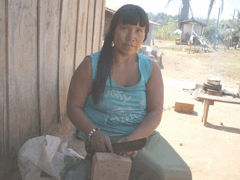
The forest provides: a young Surui woman chops nuts. They yield worms to eat and decorative jewelry. (Photo: Bruce Gellerman)
GELLERMAN: Hey, Bobby…take a close look at what she’s doing.
BASCOMB: Oh, those aren’t nuts, those are worms. What are they for? Are those for lunch? Para desauno, para comida?
WOMAN: Comida.
GELLERMAN: And then she’s cutting the shell, watch. She’s cuts the shell. Yeah, she’s cutting the beads, yeah, she’s making beads.
[CHOPPING SOUNDS]
BASCOMB: Ahhh.
[GRASS CRUNCHING; WALKING SOUNDS]
BASCOMB: It’s a short hike to the forest where the Surui gather these nuts. As we walk Chief Almir details his 50-year management plan. The tribe will continue to protect the forest as they’ve always done, and replant 18 thousand acres of trees illegal loggers cut down on Surui territory.
GELLERMAN: All told, the tribe plans to grow a million new trees. So far, they’ve planted 80 thousand.
ALMIR: [Translation] I think what we should do is make this a forest again. Let area receive species that always belonged to here. Feel the air, smell this, so delicious.
[SOUNDS OF BREATHING AIR IN]
ALMIR: Not only through nose, but don’t you feel your skin breathing?
GELLERMAN: Can you restore the forest to the condition that it was before it was destroyed?
ALMIR: [Translation] Yes, we definitely can. That’s why we are researching areas that are today pasture so we can through science understand what kind of species used to live here. And then we can apply to every area according to its needs.
[WALKING NOISES; ALMIR SPEAKING PORTUGUESE]
ALMIR: [Translation] This is a result of re-forestry already. This is also hardwood – mahogano – Brazilian cherry.
BASCOMB: Yeah, how did you choose these trees? Why these trees and not some other kind?
ALMIR: [Translation] The way we thought and planned was let’s replant the trees that suffered the bigger impact. And we also choose fruit trees that can feed our people. And we also picked trees that have big importance on our rituals, things that really make a difference for our culture.
ALMIR: [Translation] Our main idea is to make use of the forest the way it is. Keeping it. Preserving it. Respecting the forest, using the forest the way it, first of all, is going to remain preserved, and then of course in a way it can also benefit not only us, but also the rest of the world.
[BIRD SOUNDS]
GELLERMAN: What is that?
ALMIR: [Translation] “Ah….they are coming,” that’s what they are saying.
CURWOOD: Bruce Gellerman and the Akakai bird - and the Surui believe its calls warn them when they're being watched. Now, nearly four years since we recorded those calls - many people are watching in the Surui's forest. Loggers are still there, and still a threat - but scientists seeking to protect the forest are there too - and their work is close to paying off. Living on Earth's Bobby Bascomb has an update on the latest developments.
BASCOMB: When I first visited the Surui village they were mapping the boundaries of their forest and marking important cultural sites. Today they are busy mapping individual trees using a smart phone. Rebecca Moore, the engineering manager for Google Earth Outreach, is working with the Surui on the project.
MOORE: They they’re using Google Android smart phones that allow the Surui to go out into their forest and do a survey and gather information let’s say about the diameter and species of the trees, the locations of the trees, and that ends up being aggregated and estimating the entire volume of forest that they have for which they are compensated.
BASCOMB: Before smart phones came to the Amazon Surui researchers went out into the forest with GPS units strapped to their back and kept detailed notes in notebooks and on laptop computers. It would take days or weeks to compile all the data. But now….
MOORE: They collect the data and it’s automatically time-stamped, GPS-located, and it goes into their database and the calculations are automatically performed.
BASCOMB: They need to be able to go back to the same trees years later and measure them again to see how much they’ve grown. Then they can calculate how much carbon the trees have absorbed in the process.
MOORE: What they’re gonna do is put barcodes on the trees, and the Google Android smartphone will recognize, oh this is tree 1234, it was this amount of biomass five years ago and this is how much it is now.
BASCOMB: So are you telling me that if I walk through their forest, there’s gonna be barcodes in the trees like in the grocery store?
MOORE: (laughs) I guess, but the size of the barcode relative to the size of these trees in the Amazon—I don’t think you will notice the barcode.
BASCOMB: So far so good. But this is the Amazon, an extremely hostile environment. It’s hot, it rains a lot, and everywhere you turn there are animals.
MOORE: It turns out that there are leaf cutter ants that like plastic and they chew through the plastic barcodes, so there needs to be other experiments with new materials that are more resistant to leaf cutter ants and to apparently the monkeys that like the metal tags.
BASCOMB: Monkeys run off with the shiny metal tags and leaf cutter ants chew up the plastic ones. But in spite of those challenges Chief Almir says they've been able to calculate how much carbon is locked up in their trees – and it’s a lot.
SURUI: We have calculated that the Surui will be avoiding the emissions of about 100,000 tons of carbon into the air every year by protecting our territory and avoiding that it gets deforested.
BASCOMB: 100,000 tons of carbon is roughly equal to the carbon dioxide emitted by 22,000 US cars in a year.
At the moment Almir is reluctant to estimate how much money the carbon credits will generate for his tribe. But Rebecca Moore says the mapping they’ve already done actually makes their trees more valuable.
MOORE: You can charge more for carbon that has social and environmental co-benefits. Under various financial mechanisms, if your forest provides livelihood to indigenous people, if it is a natural ecosystem that houses biodiversity, if it has rivers within it, if there’s certain—it’s called ecosystem services—a natural forest, an intact landscape can provide, you can charge more for the carbon in your trees, and so documenting that with the cultural map actually brings this additional financial benefit to them as well.
BASCOMB: It’s a long complicated process to go from mapping trees to actually getting checks in the mail for protecting them and the carbon they contain. The Surui project was recently validated under the verified carbon standard. That guarantees the carbon credits are legitimate and the environmental benefits are real.
The very first REDD project to get paid is the Kasigau Corridor in Southwest Kenya near the Tanzanian Border. Michael Korchinksy is CEO and founder of Wildlife Works, the NGO organizing that project.
KORCHINSKY: We came to this part of Kenya nearly 16 years ago with the idea of implementing a new conservation model that would be based on innovative market forces rather than the typical charitable model.
BASCOMB: Korchinsky worked with locals to protect 500,000 acres of dryland forest that’s home to a diversity of African wildlife including elephants, lions, and buffalo. The area lies between two national parks and was under increasing pressure from subsistence agriculture.
KORCHINSKY: The conflict in the corridor between people and wildlife was becoming quite intense so thought if we can bring a model that can solve this intense conflict then that model will probably work elsewhere.
BASCOMB: The United Nations, the official organizer of REDD, is still a few years away from developing a formal program to pay countries for protecting their forests so the Kenya project decided to work outside the UN.
KORCHINSKY: For those of us in conservation every year is precious. We loose more forest every year so we decided that we would see if we could jump the gun and get started with the private sector and not wait for the global solution to come from the UN.
BASCOMB: And private companies committed to running carbon-neutral operations are supporting it. The Kasigau Corridor’s largest customers are the South African bank, Nedbank and a European insurance company called Allianze.
The project had to go through 3 rounds of independent audits to certify how much carbon is locked up in the trees and that those trees are actually being protected. But it paid off.
KORCHINSKY: The project is avoiding about 1.2 million tons a year for 30 years. So approximately 35 million tons of emissions over the life of the project.
BASCOMB: The price of carbon on the Voluntary Carbon Market, the only place with a working carbon market, is currently $8 per ton. That means that 1.2 million tons will yield the project more than 9 million dollars a year. One third of that money goes to institutional costs but the remaining two thirds goes directly to the community. 6 million dollars a year can go a long way in Kenya.
KORCHINSKY: One of the things about REDD, in our opinion, is that the scale of finance available through REDD, if REDD continues to be successful it can be transformative for communities.
BASCOMB: In this case the community decided to spend the bulk of their REDD money on education and clean water projects.
KORCHINSKY: We think REDD is a fantastic mechanism to empower forest communities to protect their forest and benefit yet economically. Most forest communities like forest. They live in forest because they like forest and don't want to see their forest destroyed around them. But they need economic power to prevent others from destroying forest around them.
BASCOMB: Empowering forest communities through REDD is a growing trend around the world from Panama, to Cambodia to the Democratic Republic of Congo.
The Surui project in the Amazon is the first indigenous REDD project in the world. It’s also the first REDD project of any kind in Brazil, and only the second in the world to get validated. Chief Almir Surui says that the health of his community and the health of the forest are one and the same.
SURUI (Through Translator): My family we cannot live without the forest as much as we cannot live without our culture. We need the forest and our culture to survive and live. What we want to achieve by developing a green economy, developing a sustainable way of life, is guaranteeing the future, guaranteeing the future of the next generations.
BASCOMB: Within a few months the Surui expect to wrap up the REDD certification process and start getting paid for protecting the forest they’ve lived in for millennia. And Surui leaders hope REDD will help guarantee a healthy forest for future generations of the tribe. For Living on Earth I’m Bobby Bascomb.
[MUSIC: Apollo Nove “Fruta Vermelha” from Res Inexplicata Volans (Crammed Discs 2005).]
CURWOOD: Our update from Brazil was made possible by a fellowship from Earth
Journalism Network. You can find pictures of the Surui village over at our website loe.org.
Related links:
- Listen to the Full Story about the Surui
- Listen to the Full Hour Long Documentary about REDD in Brazil
[MUSIC CONTINUES]
CURWOOD: Coming up – how sea otters can help fight climate disruption. Keep listening to Living on Earth!
ANNOUNCER: Support for Living on Earth comes from Breckinridge Capital Advisors, applying a sustainable approach to fixed income investing, www.breckinridge.com, the Grantham Foundation for the protection of the environment, supporting strategic communications and collaboration in solving the world’s most pressing environmental problems, the Gordon and Betty Moore Foundation and Gilman Ordway, for conservation and environmental change. This is Living on Earth on PRI, Public Radio International.
[CUTAWAY MUSIC: Marc Johnson/Eliane Elias: “B is for Butterfly” from Swept Away (ECM Records 2012).]
Otters and Climate Change
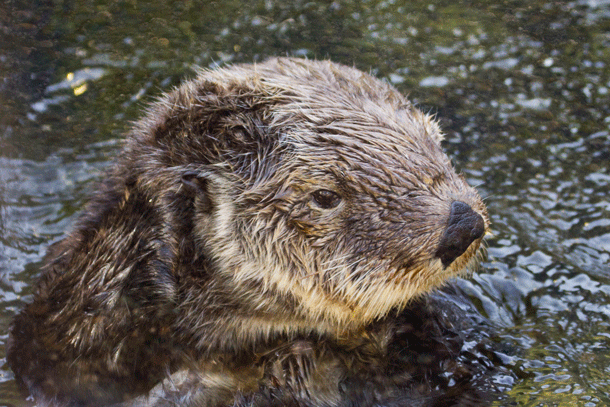
A sea otter in the Vancouver Aquarium (Photo: Imtiaz333 Flickr Creative Commons)
CURWOOD: It's Living on Earth - I'm Steve Curwood. Sea otters are cuddly, cute and playful, but a recently published report from the University of California at Santa Cruz claims they could hold one of the keys to mitigating climate change. Two scientists from UCSC have demonstrated the crucial role that sea otters play in the health of kelp forests, one of the ocean’s great carbon sinks. If we want to sequester more carbon from the atmosphere, they say, we need more otters. Joining us now from the University of California at Santa Cruz is Chris Wilmers, professor of Environmental Studies. Professor, welcome to Living on Earth.
WILMERS: Thank you, glad to be here.
CURWOOD: So, sea otters as climate warriors - what made you think to connect the otter with climate disruption?
WILMERS: Well, I do a lot of work on the effects of predators more generally on ecosystems. And one thing we’ve been seeing for a long time now is that predators can have a dramatic impact on plant populations through their intermediary impact on their prey. So, when otters eat sea urchins, which are their main diet for instance, we see kelp forest bounce back to life. And my research has also focused a bit on climate change and so I thought I wondered if there was a connection between the two.
CURWOOD: So, explain to me your study and the specifics of the findings that you have.
WILMERS: Well, over 40 years or so, my co-author and colleague Jim Estez has been looking at the effect of sea otters on coastal ecosystems. And what he’s shown over that time period is that when you have otters, you have these abundant kelp ecosystems. When you remove otters, the kelp forests disappear. And what’s novel about this study is that we looked at… how that influences carbon. And what we found is that there’s a dramatic draw-down of carbon from the atmosphere when you have sea otters and all that underwater kelp using that carbon.
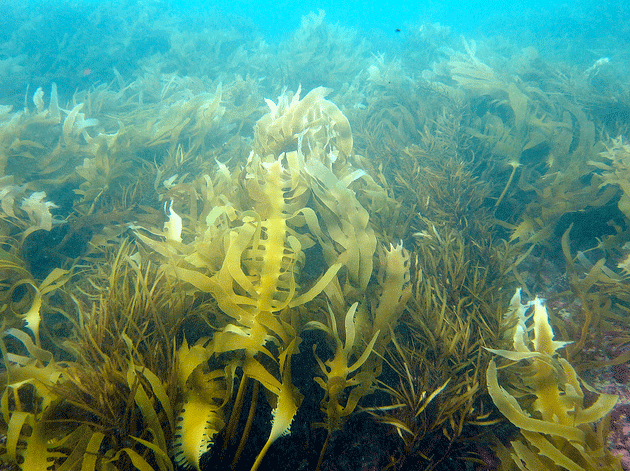
Kelp beds protected by otters absorb 12 times more carbon dioxide than those that are thinned out. (Photo: Saspotato Flickr Creative Commons)
CURWOOD: And what’s the mechanism? I mean, the sea otters are related to urchins are related to kelp… explain that for me please.
WILMERS: So sea otters eat sea urchins. When you have sea otters around, you have fewer sea urchins and the ones that you do have - they sort of hide in the crevices between rocks. If you get rid of the sea otters, the sea urchins come out of the crevices, start crawling around on the sea floor, eating all the kelp they can find, their populations increase and the kelp declines to nearly nothing.
CURWOOD: So currently what is the population of sea otters and what would a healthy population look like?
WILMERS: Well, the area that we were doing our work is mainly the Aleutian Islands, but then also the coast of North America down to the Canadian/US border. And in that area, there used to be probably a few hundred thousand sea otters. That population has declined dramatically over the last 20 or 30 years by a somewhat mysterious switch in feeding patters by killer whales.
CURWOOD: Killer whales?
WILMERS: Killer whales, yeah! So, the theory is that killer whales used to eat primarily the large baleen whales. And after World War II there was a tremendous increase in whaling which depleted most of the large baleen whales over much of the north Pacific. So by the 70s or 60s there were very few baleen whales remaining.
And so the killer whales that remained switched to a new food source - and that turned out to be harbor seals. And then they depleted harbor seals so they switched to feeding on fur seals. And then they depleted fur seals and they switched to feeding on Steller sea lions. And, the depleted the Steller sea lion populations so finally the switched to feeding on otters. They drove the otter population down from a few hundred thousand to just a few thousand.
CURWOOD: So, intensive whaling is indirectly connected to more climate disruption.
WILMERS: Yeah, in a sense you could say that. There’s been a sort of chain of cascading events that initiated back in the 1950s with heavy whaling.
CURWOOD: Given the current population of otters and their appetite for sea urchins that would otherwise eat kelp, how much carbon do you think that they are helping stay sequestered - what might that be worth on the international carbon exchanges?
WILMERS: Well, we did a calculation in our study using the current price of carbon on the European carbon market. And we valued the carbon that sea otters indirectly sequestered using that value and it came out to be somewhere in between 205-400 million dollars, just in the carbon sequestered by the living kelps themselves.
CURWOOD: How might you use that dollar amount to affect the status of sea otters?
WILMERS: Well, the hope would be that you could use that money to reintroduce sea otters and restore the kelp forests. Right now, carbon markets are very young and they’re still evolving and I’m not sure that you could actually sell that carbon on the market today. But, as those markets evolve, we hope that there will be mechanisms to do that kind of thing and that kind of money could be used to figure out how to reintroduce otters or restore them to historic populations and get back all that carbon into the ocean.
CURWOOD: So, what do you hope will come out of this research?
WILMERS: I think one of the main things that I hope will come out of this research is the influence that animals can have on the carbon cycle. So far most of the carbon cycles don’t incorporate animals - they incorporate plants, certainly - but animals have been largely overlooked because it’s been assumed that they are bit players in the carbon cycle. But what I think this study shows is that the role of animals can be quite significant, and that ecologists more generally should be looking the world over for roles that animals might be playing in other kinds of ways in other kinds of ecosystems that influence the carbon cycle.
CURWOOD: Chris Wilmers is a Professor of Environmental Studies at the University of California at Santa Cruz. Thank you so much for taking this time today!
WILMERS: Thank you!
[MUSIC: Nicky Hopkins “Edward” from The Tin Man Was A Dreamer (Sony Music 1972).]
Toads in Tucson
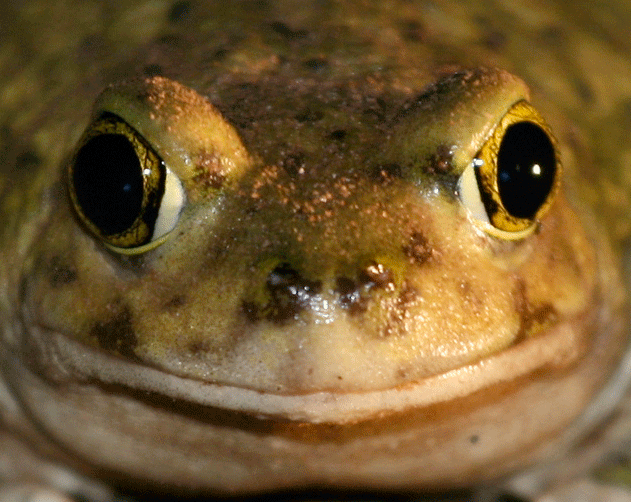
Couch’s Spadefoot Toad (Photo: Reptilist Flickr Creative Commons)
CURWOOD: Think the US southwest, and most likely you'll envision hot, dry, dusty landscapes and terra cotta colored desert towns. But it does rain there - sometimes torrentially. And when that happens - streets flood and ponds suddenly appear, making prime breeding habitat for mosquitoes. In the cities, local officials try to rid of the standing water - but for some desert animals those brief pools can mean the difference between life and death. From Tucson, Sarah Bromer has the story.
BROMER: I was out taking a walk one night after a summer storm in downtown Tucson when I heard a sound I’d never heard before:
[SOUND OF TOADS]
BROMER: It kind of sounded like a flock of sheep.
[SOUND OF TOADS]
BROMER: But that seemed unlikely, given that I only live a few blocks from the center of downtown.
[CROAK]
BROMER: So I followed the sound, to the edge of my neighborhood, where I found people gathered with flashlights.
[EXCLAMATIONS OF SURPRISE,]
BROMER: There, in a temporary drainage pond next to a shipping warehouse, were dozens of toads.
[TOAD SOUNDS]
BROMER: Now amphibians are pretty much the last animals you expect to find in a dry, dusty, desert town like Tucson, and nobody seemed to know much about them. So I called an expert.
ROSEN: So I’m Phil Rosen, and I’m a research scientist in Natural Resources and the Environment at the University of Arizona.
BROMER: I took Phil to the pond the next night, and we listened.
[SILENCE OF AN EMPTY POND]
BROMER: But all we heard was…silence. The pond looked a lot smaller. We found tadpoles in the water, but no toads, so I tried to explain the sound to him.
BROMER: Yeah, it sounded like wwwaaaahhhh! [imitate sound]
ROSEN: wwwwaaaaahhh? [imitates sound]
BROMER: Yeah, like that.
BROMER: Phil was pretty sure that I’d heard Couch’s spadefoot toads.
ROSEN: I fully expected it to be nothing but Couch’s spadefoot, because of their ability to use such short-lived water. They’re uniquely explosive breeders with very short tadpole stages.
BROMER: He told me the toads spend most of their lives underground, emerging each summer for maybe only a few nights of frantic feeding and breeding. Their eggs hatch within hours, and only seven or eight days later the tadpoles become toads.
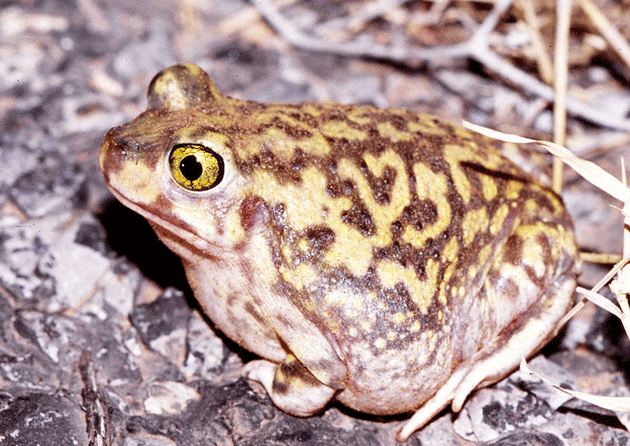
Couch’s Spadefoot Toad. (Photo: Tom Spinker)
ROSEN: It’s fastest metamorphosing species here, probably one of the fastest in the world.
BROMER: I thought Phil would be really excited to find prime toad breeding habitat in the middle of the city, but he wasn’t very excited at all. He told me that the water in the pond probably wouldn’t last long enough for the tadpoles to turn into toads.
ROSEN: This basin that we’re standing next to is designed to uh dry itself within three days. It’s too bad because it is like an ecological trap because it just seems really good for them but it’s… huh... It’s an attractive nuisance for them, basically. It brings them into breed in a place they can’t survive.
BROMER: Tucson’s building codes require all businesses to capture their run-off, so it won’t contribute to flooding, and then sink the water into the ground quickly, so it won’t breed mosquitoes. Here’s Phil Rosen again.
ROSEN: Well, you know, this sort of thing worries me, because it exemplifies the ability and the tendency of people to just keep modifying the environment, and making it more and more perfect for people, and, unfortunately, there’s less tendency for there to be little corners where water lasts for two or three or four weeks…and so I suspect there’s an ongoing, very steady decline of these species throughout most the city.
BROMER: Now you wouldn’t think mosquitoes would be a big problem in the Southwest. Tucson gets less than 12 inches of rain a year. But over half of it falls during what people around here call the monsoon season, in July, August, and September. It floods the streets and forms temporary pools all over the city. And when the water comes, so do the mosquitoes.
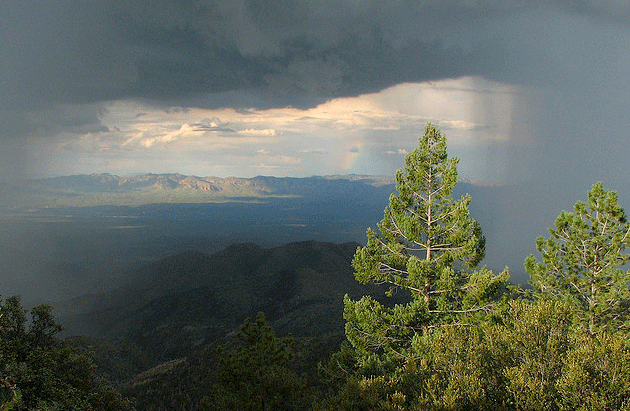
A monsoon storm heating up in Pima County, AZ. (Photo: Katja Schulz)
ACOBA: Mosquitoes really just need water and a warm blood source in order to thrive, so we do have that in Tucson, especially during the times of our monsoon, when we have a lot of rain.
BROMER: That’s Dr. Michael Acoba. He’s the head of epidemiology at the County Health Department
ACOBA: Well, the majority of the time, the mosquitoes we have, they’re just a nuisance, but since 2004, we had our first case of West Nile Virus here. The number of cases spiked one year to about 40 cases, but usually we see about 10-20 cases a year.
BROMER: So what if we want toads in our neighborhood, but not mosquitoes? According to Phil Rosen, it’s possible to have one without the other.
ROSEN: If a pond, let’s say, like this one lasted say on average 2 to 3 months, it would be so full of predatory crustaceans and insects, that it wouldn’t really produce any mosquitoes.
BROMER: To prove his point he took me to a nearby drainage basin, in a neighborhood squeezed between the freeway and the dry Santa Cruz riverbed. The basin was dammed up at one end with sediment and old tires, and its concrete sides were covered with graffiti.
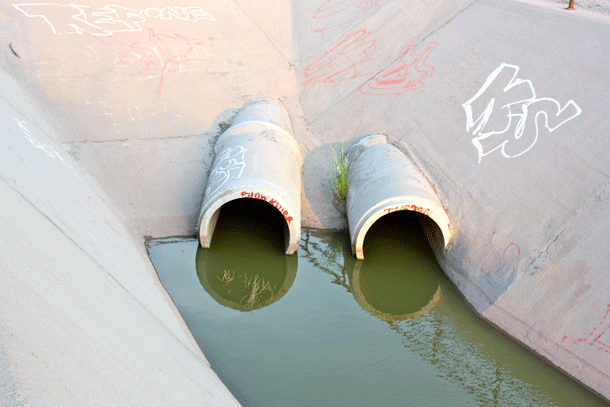
At least 5 species of toads use this concrete drainage ditch for reproduction. (Photo: Sarah Bromer)
[TRILLING TOADS FADE IN]
BROMER: It was not a pretty sight. But it was full of toads.
ROSEN: So this is a highly engineered, concrete drainage outlet, and the mouth of it is blocked by flood debris, and so it’s formed a pretty deep pool, and right now there are two species of true toads breeding it. Those loud ones are Great Plains Toads and the more musical trill are Red-spotted toads.
BROMER: We climbed down to the water and Phil pointed out all the tiny animals that eat mosquito larvae.
ROSEN: I’m interested in the invertebrates here. There’s all kinds of little beetles swimming around here whose larvae will eat mosquitoes. There’s a tadpole shrimp. There’s quite a few of them. Trying to see if there’s any mosquito larvae…because everyone would sort of expect there to be tons of mosquito larvae in a place like this, making it a public health nuisance. But with this number of aquatic invertebrates, mosquitoes might have a very hard time surviving here…and I’m not seeing any.
BROMER: The County Health Department here deals with mosquitoes by either eliminating standing water or treating it a larvicide. Jeff Terrell manages the vector control program for the department.
TERRELL: Well larvicide we use it’s usually like a—what they call a—BTI, which is a bacteria. Um we do use a larvicide oil which is more of a mineral oil with a surfactant that spreads over the water and keeps it, you know, keeps the um larvae from breaking the water surface and breathing so they drown.
BROMER: Both BTI and mineral oil, if used correctly, are generally considered safe for toads and other vertebrates. But at least one study showed that BTI might sometimes target insects it’s not supposed to, and the oil kills several of the aquatic invertebrates that serve as natural pest control.
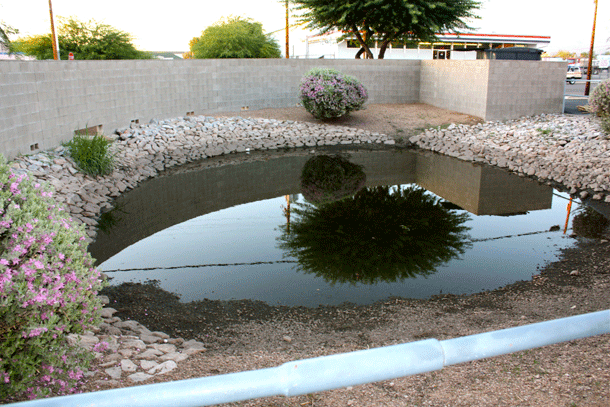
A drainage pond after summer rains attracts toads. (Sarah Bromer)
Phil Rosen suspects that the oil isn’t good for tadpoles, either. He’s been researching alternative solutions, and local officials have been open to his ideas. He’s been working with them to design experimental pools of longer-standing water that use invertebrate biodiversity to control mosquitoes.
ROSEN: So, I’ve been working to develop that it into kind of an art form…because I completely sympathize with people not wanting to live around lots of mosquitoes.
BROMER: He believes that in the long run his solution, though more complicated, will be the best one.
ROSEN: You know, if we simplify our environment, we’re going to end up with just the things we can’t deal with, diseases, and vectors, and things like that. We’ll either have to reengineer everything so there’s zero standing water, or we’ll have to try to live with the biodiversity and turn it to our ends and …let the kids growing up have something interesting to grow up with…
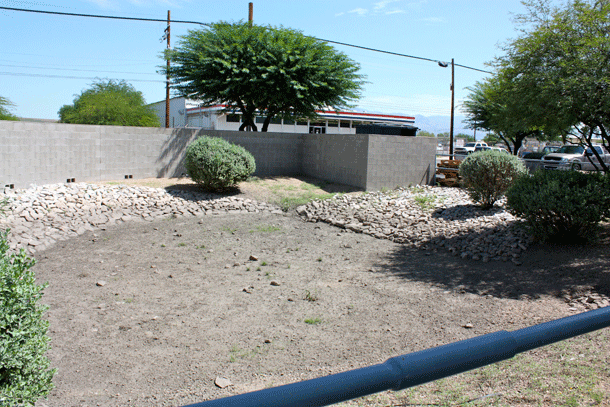
The same drainage pond three days later has dried up completely. (Photo: Sarah Bromer)
BOMER: I went back to the pond in my neighborhood a few days later, and, as Phil had predicted, all of the water was gone. Birds were pecking at the muck. I guess it wasn’t a good year for the Couch’s spadefoots of downtown Tucson. But maybe someday this pond will be reengineered …
[SOUNDS OF SPADEFOOT TOADS]
BROMER: …and stocked with the right kinds of invertebrates, which will allow us to have the best of both worlds: a neighborhood that’s rich with biodiversity and singing toads, and not too many mosquitoes. For Living On Earth, I’m Sarah Bromer in Tucson.
[MUSIC: Doug Wamble “The Bear And The Toad” from Bluestate (Marsalis Music 2010).]
CURWOOD: Living on Earth is produced by the World Media Foundation. Our crew includes Bobby Bascomb, Eileen Bolinsky, Bruce Gellerman, Jessica Ilyse Kurn, Helen Palmer, and Ike Sriskandarajah, with help from James Curwood, Meghan Miner, Gabriela Romanow and Sammy Sousa. Our intern is Emmett Fitzgerald. Jeff Turton is our technical director. Alison Lirish Dean composed our themes. You can find us anytime at L-O-E dot org - and check out our facebook page it’s PRI’s Living on Earth. I'm Steve Curwood. Thanks for listening!
ANNOUNCER: Funding for Living On Earth comes from the National Science Foundation, supporting coverage of emerging science. And Stonyfield Farm, organic yogurt and smoothies. Stonyfield invites you to just eat organic for a day. Details at just eat organic dot com. Support also comes from you, our listeners, the Go Forward Fund, and Pax World Mutual and Exchange-Traded Funds, integrating environmental, social, and governance factors into investment analysis and decision making. On the web at pax world dot com. Pax world, for tomorrow.
PRI ANNOUNCER: PRI, Public Radio International.
Living on Earth wants to hear from you!
Living on Earth
62 Calef Highway, Suite 212
Lee, NH 03861
Telephone: 617-287-4121
E-mail: comments@loe.org
Newsletter [Click here]
Donate to Living on Earth!
Living on Earth is an independent media program and relies entirely on contributions from listeners and institutions supporting public service. Please donate now to preserve an independent environmental voice.
NewsletterLiving on Earth offers a weekly delivery of the show's rundown to your mailbox. Sign up for our newsletter today!
 Sailors For The Sea: Be the change you want to sea.
Sailors For The Sea: Be the change you want to sea.
 The Grantham Foundation for the Protection of the Environment: Committed to protecting and improving the health of the global environment.
The Grantham Foundation for the Protection of the Environment: Committed to protecting and improving the health of the global environment.
 Contribute to Living on Earth and receive, as our gift to you, an archival print of one of Mark Seth Lender's extraordinary wildlife photographs. Follow the link to see Mark's current collection of photographs.
Contribute to Living on Earth and receive, as our gift to you, an archival print of one of Mark Seth Lender's extraordinary wildlife photographs. Follow the link to see Mark's current collection of photographs.
 Buy a signed copy of Mark Seth Lender's book Smeagull the Seagull & support Living on Earth
Buy a signed copy of Mark Seth Lender's book Smeagull the Seagull & support Living on Earth

